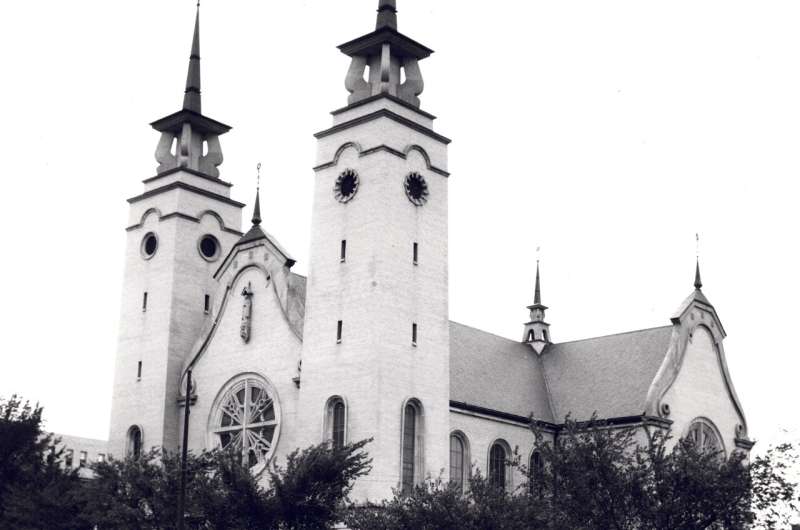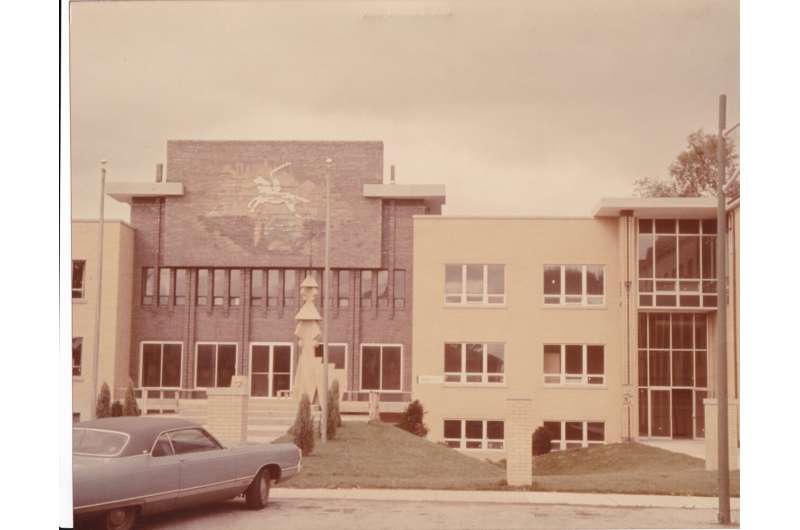This article has been reviewed according to Science X's editorial process and policies. Editors have highlighted the following attributes while ensuring the content's credibility:
fact-checked
trusted source
proofread
Resilience in architecture: The diaspora's response to the Second World War

The Second World War had a profound impact not only on the fate of countries and people but also on the development of architecture. In occupied territories across the globe, architecture reflected the prevailing trends of the time.
Meanwhile, war refugees continued their attempts to shape the architectural landscape in their new homes to preserve their cultural identity. According to Vaidas Petrulis, an expert in architecture at Kaunas University of Technology, Lithuania, this phenomenon is an important part of architectural history, worthy of both greater interest and international recognition.
Vaidas Petrulis, the Head of the Research Center of Architecture and Urbanism at KTU, argues that the works of emigrant architects can significantly contribute to the understanding of the architectural traditions of a country and give a broader context for the reasoning behind various processes.
Researching the history of architecture for more than 20 years, he believes that the architectural heritage of emigrants should be studied as a form of globally shared heritage.
A reminder of past mistakes
As the concept of heritage has expanded in recent decades, it is no longer just a collection of the most beautiful or technologically impressive buildings but also evidence of past processes.
"Some testimonies reveal the creativity and progress of mankind, while others warn of mistakes," explains Petrulis.
Wars and their aftermath are one of humanity's biggest catastrophes, marked not only by destroyed cities, concentration camps, or mass graves but also by people's attempts to survive.
"Being in exile and using creativity to send a message about a nation's right to statehood is another significant story," says Petrulis.
Although the original political purpose of the buildings designed in the diaspora after World War Two is gradually fading, KTU researcher believes that in the current situation, the recognition of such heritage is even more significant.
"Today, when the world is facing threats again, such phenomenon takes on a new meaning. It is not only a reflection of the past but also a reminder for the present and future generations," says Petrulis, a senior researcher at the Institute of Architecture and Construction.
In his opinion, the heritage of the refugees should not only be appreciated by society but also included in the UNESCO World Heritage List. The researcher believes that not only the community that created these buildings but also the state that hosted the refugees should consider them valuable.
"For example, the reception of refugees from Europe should be interpreted as an integral and significant part of American and Canadian history. In this way, the heritage would become a shared one," the expert argues.
Inclusion on the UNESCO World Heritage List would not only honor the memory of those who have survived the challenges of the diaspora but also remind the rest of us about the mistakes made in the past.
"Unfortunately, war refugees and their fate in exile continue to be a pressing issue in the 21st century," says Petrulis.

Architecture with a political agenda
KTU researcher and his team explored the Lithuanian architectural legacy in the United States of America (U.S.) after World War Two.
Petrulis says that emigrants from Lithuania have been choosing the U.S. as a destination for emigration for a long time. After the Second World War, around 40 thousand Lithuanians came to North America to escape the repressions of the Soviet Union. Unlike previous emigrants, they were considered war refugees.
"Along with this wave of emigration, several architects who had already started their careers in Lithuania came to North America. Their education did not guarantee professional practice opportunities, so they had to overcome not only the language barrier but also obtain local certificates allowing them to practice as architects. The younger generation, who enrolled in higher education institutions in the U.S. or Canada, found it easier to integrate," says the researcher, architectural historian.
According to him, the difficult professional adaptation significantly contributed to the fact that the new arrivers tended to seek commissions from the Lithuanian community. This created a political task for architecture: the newly constructed buildings had to contribute to the promotion of national identity.
"Architecture was serving the purpose of not only creating a recognizable and attractive place for the community to gather but also for presenting the name of Lithuania to the world. It was expected that the buildings, designed by Lithuanians, would once again remind the world about Lithuania, its culture, language, and history," says Petrulis.
Architects continued local architectural tradition in diaspora
After the Second World War, other emigrants also tried to promote their architecture in the US: the Polish built churches with Baroque towers, and in Chicago's Ukrainian town, churches were decorated with their characteristic domes. However, as Petrulis points out, Lithuanians were the leaders in the search for a distinctive architectural character.
The architects who remained in Lithuania had to adapt to the realities of occupation. Immediately after the Second World War, modern architecture, for which, as Petrulis reminds us, Kaunas was listed as a UNESCO World Heritage Site in 2023, was replaced by the Stalinist regime and its architecture.
"Later on, modernism returned to the Soviet Union, but the economic version of it was created under the political slogan: cheaper, more, and faster. Most of the time, that also meant poorer. It is not surprising that the architects who left Lithuania felt obliged to continue the native architectural tradition, which was restricted in conditions of occupation," adds the associate professor of KTU.
Sharing the results of his research, Petrulis reveals that the architectural style of the Lithuanian diaspora was influenced by faith: "The majority of the Lithuanian diaspora in the U.S. were Catholics, so it is not surprising that this generation of war refugees built churches, monasteries, and—in their neighborhoods—schools and cultural centers."
One of the most striking examples of this architecture was the construction of the Church of the Nativity of the Blessed Virgin Mary in Chicago, which reflects elements of neo-Baroque and ethnic architecture.
"Perhaps the most original solution is the interpretation of Lithuanian wooden chapels in brick construction. The monumental, wood-carving inspired crowns on the towers are a unique sign of Lithuanian identity in the U.S., which cannot be found neither in Lithuania's nor other countries' architecture," says the KTU researcher.
The architect adds that the complex of the Jesuit monastery and the Youth Center in Chicago also reflects the Lithuanian identity. According to him, the visual accent—a colored brick wall with the silhouette of Vytis (Lithuanian coat of arms)—does not allow questioning the purpose of the building.
The research is published in the journal Buildings.
More information: Vaidas Petrulis et al, The Architectural Legacy of Lithuanians in the United States during the Post-World War II Era: A Monument to the Cold War, Buildings (2023). DOI: 10.3390/buildings13123138
Provided by Kaunas University of Technology



















